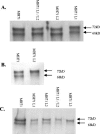Identification of domains in gag important for prototypic foamy virus egress
- PMID: 15858022
- PMCID: PMC1091687
- DOI: 10.1128/JVI.79.10.6392-6399.2005
Identification of domains in gag important for prototypic foamy virus egress
Abstract
Sequence motifs (L domains) have been described in viral structural proteins. Mutations in these lead to a defect at a late stage in virus assembly and budding. For several viruses, recruitment of an endosomal sorting complexes required for transport 1 subunit (Tsg101), a component of the class E vacuolar protein sorting (EVPS) machinery, is a prerequisite for virion budding. To effect this, Tsg101 interacts with the PT/SAP L domain. We have identified candidate L-domain motifs, PSAP, PPPI, and YEIL, in the prototypic foamy virus (PFV) Gag protein, based on their homology to known viral L domains. Mutation of the PSAP and PPPI motifs individually reduced PFV egress, and their combined mutation had an additive effect. When PSAP was mutated, residual infectious PFV release was unaffected by dominant negative Vps4 (an ATPase involved in the final stages of budding), and sensitivity to dominant negative Tsg101 was dramatically reduced, suggesting that the PSAP motif functions as a conventional class E VPS-dependent L domain. Consistent with this notion, yeast two-hybrid analysis showed a PSAP motif-dependent interaction between PFV Gag and Tsg101. Surprisingly, PFV release which is dependent on the PPPI motif was Vps4-independent and was partially inhibited by dominant negative Tsg101, suggesting that PPPI functions by an unconventional mechanism to facilitate PFV egress. Mutation of the YEIL sequence completely abolished particle formation and also reduced the rate of Gag processing by the viral protease, suggesting that the integrity of YEIL is required at an assembly step prior to budding and YEIL is not acting as an L domain.
Figures





Similar articles
-
Characterization of prototype foamy virus gag late assembly domain motifs and their role in particle egress and infectivity.J Virol. 2005 May;79(9):5466-76. doi: 10.1128/JVI.79.9.5466-5476.2005. J Virol. 2005. PMID: 15827161 Free PMC article.
-
Functional interchangeability of late domains, late domain cofactors and ubiquitin in viral budding.PLoS Pathog. 2010 Oct 21;6(10):e1001153. doi: 10.1371/journal.ppat.1001153. PLoS Pathog. 2010. PMID: 20975941 Free PMC article.
-
Identification of human VPS37C, a component of endosomal sorting complex required for transport-I important for viral budding.J Biol Chem. 2005 Jan 7;280(1):628-36. doi: 10.1074/jbc.M410384200. Epub 2004 Oct 27. J Biol Chem. 2005. PMID: 15509564
-
[HIV budding and Tsg101].Uirusu. 2005 Dec;55(2):281-6. doi: 10.2222/jsv.55.281. Uirusu. 2005. PMID: 16557014 Review. Japanese.
-
The foamy virus Gag proteins: what makes them different?Viruses. 2013 Mar 26;5(4):1023-41. doi: 10.3390/v5041023. Viruses. 2013. PMID: 23531622 Free PMC article. Review.
Cited by
-
The YLDL sequence within Sendai virus M protein is critical for budding of virus-like particles and interacts with Alix/AIP1 independently of C protein.J Virol. 2007 Mar;81(5):2263-73. doi: 10.1128/JVI.02218-06. Epub 2006 Dec 13. J Virol. 2007. PMID: 17166905 Free PMC article.
-
Population dynamics of rhesus macaques and associated foamy virus in Bangladesh.Emerg Microbes Infect. 2013 May;2(5):e29. doi: 10.1038/emi.2013.23. Epub 2013 May 22. Emerg Microbes Infect. 2013. PMID: 26038465 Free PMC article.
-
Foamy virus budding and release.Viruses. 2013 Apr 10;5(4):1075-98. doi: 10.3390/v5041075. Viruses. 2013. PMID: 23575110 Free PMC article. Review.
-
N-terminal Gag domain required for foamy virus particle assembly and export.J Virol. 2005 Oct;79(19):12464-76. doi: 10.1128/JVI.79.19.12464-12476.2005. J Virol. 2005. PMID: 16160174 Free PMC article.
-
Discovery of prosimian and afrotherian foamy viruses and potential cross species transmissions amidst stable and ancient mammalian co-evolution.Retrovirology. 2014 Aug 4;11:61. doi: 10.1186/1742-4690-11-61. Retrovirology. 2014. PMID: 25091111 Free PMC article.
References
-
- Bieniasz, P. D., A. Rethwilm, R. Pitman, M. D. Daniel, I. Chrystie, and M. O. McClure. 1995. A comparative study of higher primate foamy viruses, including a new virus from a gorilla. Virology 207:217-228. - PubMed
-
- Bouamr, F., J. A. Melillo, M. Q. Wang, K. Nagashima, M. D. Los Santos, A. Rein, and S. P. Goff. 2003. PPPYEPTAP motif is the late domain of human T-cell leukemia virus type 1 GaG and mediates its functional interaction with cellular proteins Nedd4 and Tsg101. J. Virol. 77:11882-11895. - PMC - PubMed
Publication types
MeSH terms
Substances
Grants and funding
LinkOut - more resources
Full Text Sources
Molecular Biology Databases
Miscellaneous

